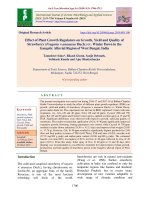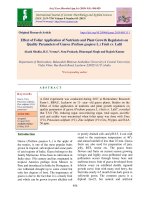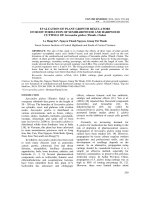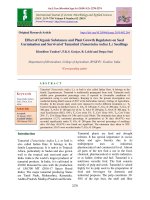Effect of foliar application of nutrients and plant growth regulators on quality parameters of guava (Psidium guajava L.) Fruit cv. Lalit
Bạn đang xem bản rút gọn của tài liệu. Xem và tải ngay bản đầy đủ của tài liệu tại đây (142.29 KB, 4 trang )
Int.J.Curr.Microbiol.App.Sci (2019) 8(5): 956-959
International Journal of Current Microbiology and Applied Sciences
ISSN: 2319-7706 Volume 8 Number 05 (2019)
Journal homepage:
Original Research Article
/>
Effect of Foliar Application of Nutrients and Plant Growth Regulators on
Quality Parameters of Guava (Psidium guajava L.) Fruit cv. Lalit
Akash Shukla, R.S. Verma*, Som Prakash, Dharmpal Singh and Rajesh Kumar
Department of Horticulture, Babasaheb Bhimrao Ambedkar University (A Central University)
Vidya Vihar, Rae Bareli Road, Lucknow-226025 (U.P.) India
*Corresponding author
ABSTRACT
Keywords
Guava, Urea,
Potassium sulphate,
Zinc sulphate, GA3,
NAA and Quality
parameters
Article Info
Accepted:
10 April 2019
Available Online:
10 May 2019
A field experiment was conducted during 2017 at Horticulture Research
Farm-1, BBAU, Lucknow on 11- year- old guava plants, Studies on the
Effect of foliar application of nutrients and plant growth regulators on
quality parameters of guava (Psidium guajava L.) fruit cv. Lalit”, revealed
that T.S.S (0B), reducing sugar, non-reducing sugar, total sugars, ascorbic
acid and acidity were maximized when foliar spray was done with Urea
(1%), Potassium sulphate (1%), Zinc sulphate (1%) GA3 50 ppm, and NAA
50 ppm.
or poorly drained soils and pH 8.5, it can with
stand to the maximum temperature at 460c
and annual rainfall of less than 25 mm. Guava
fruits are also used for preparation of jam,
jelly, RTS, nectar etc. The guava bears
flowers and fruits on current season growing
twinges and highly cross-pollinated crop and
pollination occurs through honey bees and
andirona insect, fruit of guava developed from
inferior ovary on exhibited double sigmoid
growth curve, fruit with many seed berry, the
fruit take nearly 4-5 month from dark green to
yellowish green. The common guava is a
diploid 2n=22, but natural and artificial
Introduction
Guava (Psidium guajava L.) is the apple of
the tropics, is one of the most popular fruits
grown in tropical, sub-tropical and some parts
of arid regions of India. Guava belongs to the
family Myrtaceae. It has been in cultivation in
India since 17th century and has originated in
tropical America perhaps from Mexico to
Peru and introduced in India by Portuguese. It
can withstand drought up to some extent but
only few degrees of frost. The importance of
guava is due to the fact that it is a hardy fruit
and which can be grown in poor alkaline soil
956
Int.J.Curr.Microbiol.App.Sci (2019) 8(5): 956-959
triploid (2n=33) and aneuploid exist triploid
generally produce seedless fruit. In northern
India guava plant bears flower twice or
sometimes thrice in a year. The spring
flowering is called “AmbeBahar” June or
monsoon flowering is called “MrigBahar” and
third flowering which comes in October is
called “Hast Bahar” AmbeBahar fruit ripen
from July to September and MrigBahar fruit
ripen in from November to February,
however, Hast Bahar fruit ripen in spring
season, which also known as summer season
crop.
while minimum TSS content was recorded in
control (water spray) T0. The TSS contents of
guava fruits varied from 7.66 to 12.09 in
control.
The maximum reducing sugar content
(3.91%) was obtained with foliar application
of urea 1% + NAA 50 ppm (T6), followed by
(3.72 %) urea 1% + GA3 50 ppm (T7). The
minimum value (2.88 %) was found in control
(T0). The reducing sugar contents of guava
fruits varied from 2.88 to 3.91 in control.
The highest non-reducing sugar content
(3.56%) was measured with the foliar
application of urea 1% + NAA 50 ppm (T6),
followed by (3.34%) urea 1% + GA3 50 ppm
(T7). The minimum value (2.95%) was found
in control (T0). The results, further, advocated
that higher concentration of all treatments
proved effective as compared to the lower
concentrations.
Materials and Methods
11- year- old uniform guava plants of Lalit
cultivar planted at 6x6 m a part growing in
Horticulture Research Farm-1 of Babasaheb
Bhimrao Ambedkar University Lucknow226025 were taken for the investigation. T1
(Urea 1%), T2 (Potassium sulphate 1%), T3
(Zinc sulphate 1%), T4 (GA3 50ppm), T5
(NAA 50ppm), T6 (Urea 1%+ NAA 50ppm),
T7 (Urea 1%+ GA3 50ppm), T8 (Urea 1%+
Zinc sulphate 1%), T9 (Urea 1%+ Potassium
sulphate 1%) along with T0Water spray
(control).
The maximum total sugars content of fruit
(7.72%) was recorded with foliar application
of urea 1% + NAA 50 ppm (T6), followed by
(7.08%) urea 1% + GA3 50 ppm (T7). The
minimum value (5.87%) was found in control
(T0).
First spraying of micro nutrients and plant
growth regulators were done before flowering
(first week of August) and second after fruit
set (second week of September) during 2017.
The experiment was laid out in R.B.D. with
three replications. Observations recorded to
be T.S.S (0B), Reducing sugar, Non-reducing
sugar, Total sugars, Ascorbic acid and
Acidity. The data so obtained were analysed
statically.
The highest ascorbic acid (172.07mg/100g
fruit pulp) was recorded with higher
concentration of urea 1% + NAA 50 ppm
(T6), followed by (168.42mg/100g fruit pulp)
urea 1% + GA3 50 ppm (T7). The lowest
(158.45mg/100g fruit pulp) under control
(T0).
The minimum acidity was recorded with the
application of urea 1% + NAA 50 ppm (T6),
followed by (0.56%) urea 1% + GA3 50 ppm
(T7).However, produced significantly less
acidic fruits when compared with rest of the
treatments. The fruits under control gave
significantly maximum control (water spray)
T0.
Results and Discussion
A perusal of data presented in Table 1 shows
that significant response in the maximum TSS
content was observed due to treatment urea
1% + NAA 50 ppm (T6) followed by
(11.260Brix) urea 1% + GA3 50 ppm (T7).
957
Int.J.Curr.Microbiol.App.Sci (2019) 8(5): 956-959
Table.1 Effect of foliar application of nutrients and plant growth regulators on quality
parameters of guava (Psidium guajava L.) fruit cv. Lalit”
Treatments
T.S.S
(0B)
Reducing
sugar(%)
Nonreducing
sugar (%)
Total
sugars
(%)
Ascorbic
acid(mg/1
00g)
Acidity
(%)
T0 (Control)
T1 (Urea 1%)
T2 (Potassium sulphate 1%)
T3 (Zinc sulphate 1%)
T4 (GA3 50ppm)
T5 (NAA 50ppm)
T6(Urea 1%+ NAA 50ppm)
T7 (Urea 1%+ GA3 50ppm)
T8 (Urea 1%+ Zinc sulphate
1%)
T9 (Urea 1%+ Potassium
sulphate 1%)
S.Em. ±
C.D. at 5%
7.66
9.02
9.75
9.29
9.62
10.42
12.09
11.26
10.81
2.88
3.08
3.12
3.16
3.59
3.18
3.91
3.72
3.63
2.95
3.00
3.07
3.10
3.21
3.20
3.56
3.34
3.13
5.87
6.32
6.44
6.53
6.61
6.67
7.20
7.08
6.85
158.45
162.55
163.31
164.34
165.49
164.38
172.07
168.43
166.35
0.68
0.65
0.61
0.65
0.57
0.58
0.51
0.56
0.66
10.82
3.20
3.10
6.56
165.96
0.61
0.167
0.501
0.133
0.399
0.071
0.214
0.132
0.395
1.043
3.122
0.025
0.076
In conclusion, the quality parameters of fruit
with respect T.S.S (0B), Reducing sugar, nonreducing sugar, Total sugar, Ascorbic acid
and Acidity were obtained maximum with the
foliar spray of urea 1% + NAA 50 ppm (T6).
Therefore, combined spray of urea 1% +
NAA 50 ppm (T6)can be advocated to guava
growers for serving higher yield and better of
quality of fruits.
P.K.V. Res. J., 17 (1) 78- 80.
Jain, B.P.; Das, S.R. and Verma, S.K. (1985).
Effect of growth substances and major
elements on the synthesis of major
chemical constituents of litchi (Litchi
chinensis). Haryana J. Hort. Sci.,14 (12):1-3.
Joon, N.S.; Singh, R.R., and Daulta, B.S.
(1984). Effect of foliar sprays of zinc
and urea on yield and physico-chemical
composition of ber fruits cv. Gola
Haryana J. Hort. Sci., 13(3-4): 110112.
Kumar, S.; Kumar, S. and Verma, D.K.
(2004). Effect of micro-nutrients and
NAA on yield and quality of Litchi
[Litchi chinensis (Gaertn) Sonn]cv.
Dehradun. Abst in Proc. of International
Seminar on Rec. Trend in Hi-Tech Hort.
And PHT, originated by C.S.A.U.A. &
T., Kanpur, February 4-6: 193.
Rachna and Singh, S. (2013). Effect of
gibberellic acid on periodical changes in
bio-chemical composition of ber cv.
Umran. Hort Flora Research Spectrum,
2 (1): 25-29.
References
Ali, W.; Pathak, R.A. and Yadav, A.L.
(1993). Effect of foliar application of
nutrients on guava (Psidium guajava L.)
cv. Allahabad Safeda. Prog. Hort., 23
(1-4): 14-21.
Awasthi, Priya and Lal, S. (2009). Effect of
calcium, boron and zinc foliar sprays on
the yield and quality of guava (Psidium
guajava L.) Pantnagar J. Res., 7 (2):
223-225.
Ingle, K.G.; Khan, M.A.H. and Kshirsagar,
R.E. (1993). Effect of foliar application
of nutrients on yield and quality of
guava (Psidium guajava L.) cv. L-49.
958
Int.J.Curr.Microbiol.App.Sci (2019) 8(5): 956-959
Singh, P.N. and Chhonkar, V.S. (1983).
Effect of zinc, boron and molybdenum
as foliar spray on chemical composition
of guava fruit. Punjab Hort. J., 23 (1-2):
34-37.
How to cite this article:
Akash Shukla, R.S. Verma, Som Prakash, Dharmpal Singh and Rajesh Kumar. 2019. Effect of
Foliar Application of Nutrients and Plant Growth Regulators on Quality Parameters of Guava
(Psidium guajava L.) Fruit cv. Lalit. Int.J.Curr.Microbiol.App.Sci. 8(05): 956-959.
doi: />
959


![Effect of different plant growth regulators on shooting of stem cuttings in dragon fruit [Hylocereus undatus (Haworth) Britton & Rose]](https://media.store123doc.com/images/document/2020_01/09/medium_isb1578564896.jpg)

![Effect of post harvest treatments on the shelf life and quality of guava [Psidium guajava (L.)] cv. Allahabad Safeda](https://media.store123doc.com/images/document/2020_01/14/medium_wgi1578938512.jpg)




